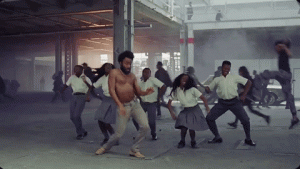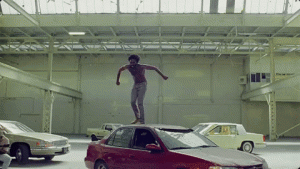THIS IS AMERICA
Today, popular rappers continue to call attention to similar issues that were prevalent during the height of gangsta rap. However, Childish Gambino’s “This Is America” grapples with what it means to be black in America in a way that is quite different to the tactics employed by N.W.A. and Public Enemy. By drawing from the past and present, Childish Gambino paints a scary picture that is, in many ways, a reality for black Americans.
Isolated from the visuals, the lyrics are pretty obvious in their insinuations regarding gun violence and black identity: “Police be tripping now / Yeah, this is America / Guns in my area.” The juxtaposition of the African sounding refrain sung by a choir to the almost generic sounding hip hop beat grounds the listener in the context of the song, but still as a part popular culture. Though it was released in 2018, there is a clear historic linage that Childish Gambino is drawing from. In addition to Gambino’s verses, key lyrics are emphasized by ad-libs from artists such as Young Thug, BlocBoy JB, Slim Jxmmi, 21 Savage, and Quavo. Though subtle, the ad-libs reiterate the video’s commentary on how popular culture is often used as a distraction from social injustice (Espinoza 2018).
The meticulous visuals are what makes Childish Gambino’s statement so powerful. The second Childish Gambino is seen on camera, his demeanor is immediately disconcerting. His facial expression looks glitchy, while his dance moves jerky. He approaches a guitarist, takes a peculiar stance, and shoots him. The pose he makes has been identified by many as strikingly similar to that of depictions of the Jim Crow character (Johnson 2018). This immediate reference to minstrelsy is deliberate and illustrates Childish Gambino’s full awareness of America’s long history of exploiting black bodies for white entertainment. After shooting the guitar player, a child in a school uniform takes the gun from him in a red cloth, while two schoolchildren haphazardly drag the dead body away- An obvious critique on laws protecting guns over people’s lives. More schoolchildren come together to dance well known dance moves alongside Childish Gambino “with the casualness of a Vine” (Osman 40). Dancing plays a huge role in the video, mainly serving as a distraction to the chaos that escalates throughout the entire video.
The next scene shows eight choir members singing the upbeat refrain of the song. Childish Gambino enters, shuffling over without crossing his legs, perhaps referencing the Jim Crow dance. Almost as quickly as the first shot, he is tossed an assault rifle and shoots the entire choir while remaining emotionless. This moment signifies the Charleston church massacre (Osman 41). Despite the acts of horror that he commits throughout the video, Childish Gambino continues to dance and perform, simultaneously causing discomfort for the viewers and commenting on how violence against African Americans has been normalized. Additionally, the shots of children video taping the chaos might comment on the sensationalization of tragedy that rarely results in change.
The inclusion of off and on screen diegeses accomplish several things. The gun shots and sounds of pandemonium add to the tension Childish Gambino is trying to create both aurally and visually. Though not included in the studio version of the song, Childish Gambino pauses at 2:44 in the music video. For a total of seventeen seconds, the only sounds heard are faint yells and the closing of doors. This break in the chaos could be considered a moment of silence for the seventeen lives lost in the Parkland shooting of 2018. However, the song promptly picks back up with an ab-lib that references social media, drawing the viewers attention away from the seriousness of the silence and back to being entertained as the cheerful refrain comes in and Childish Gambino continues to dance.
By employing minstrelsy related imagery and behaviors, Childish Gambino compares the injustices faced by today’s black population today to America’s long history of racial inequality. “This Is America” thoughtfully forces viewers to consider the paradox that black Americans have to reconcile with on a daily basis. As the video shows, popular media often only portrays black Americans as violent criminals or objects of entertainment. By tactfully and unapologetically illustrating the consequences of this practice both visually and musically, Childish Gambino is able to use his platform to spread awareness in a way that N.W.A. and Public Enemy could not as explicitly do. With the foundation that was established by these early gangsta rappers, who often faced backlash for their political music, Childish Gambino is able to be deliberate and frank about the harsh realities of racism in today’s society without pulling any punches.



